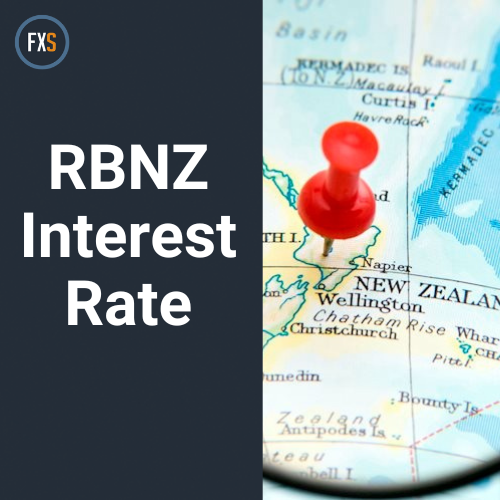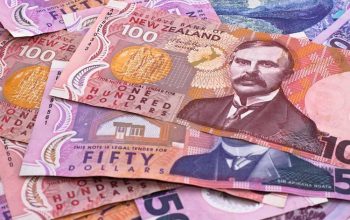- The Reserve Bank of New Zealand is set to hold the interest rate at 5.50{721fc769be108e463fe4e33f629fb22fe291c423a7a69eaaf65dcb28e9b05dea} on Wednesday.
- The language in the policy statement will offer cues on the RBNZ interest rate outlook.
- The New Zealand Dollar braces for a big reaction to the RBNZ policy announcements.
The Reserve Bank of New Zealand (RBNZ) is widely expected to maintain the Official Cash Rate (OCR) at 5.50{721fc769be108e463fe4e33f629fb22fe291c423a7a69eaaf65dcb28e9b05dea} for the sixth consecutive meeting in a row following the conclusion of its monetary policy meeting on Wednesday.
The New Zealand Dollar (NZD) is primed for a big market reaction to the RBNZ policy announcements despite the absence of RBNZ Governor Adrian Orr’s press conference and the publication of updated economic projections.
What to expect from the RBNZ interest rate decision?
As a rates on-hold decision is fully priced in, markets will closely scrutinize the language and the tone in the Reserve Bank of New Zealand’s Monetary Policy Statement (MPS).
After extending the pause in February, the RBNZ policy statement stated, “conditional on our central economic outlook, we expect the OCR will need to remain around current levels for an extended period for the Monetary Policy Committee to meet its inflation target.”
Speaking at the post-policy meeting press conference, Reserve Bank of New Zealand’s (RBNZ) Governor Adrian Orr noted that “we did discuss a hike in rates”, adding that there was a “strong consensus that rates were sufficient.”
Orr said that he is “still concerned about underlying inflation, how grown inflation is easing.”
Since the February meeting, little data of note has been released from New Zealand to help gauge the timing of the RBNZ’s likely policy pivot. However, with New Zealand’s economy facing its second recession in 18 months and consumer confidence dipping sharply, markets may not be surprised by a dovish hold.
New Zealand’s Gross Domestic Product (GDP) growth contracted 0.1{721fc769be108e463fe4e33f629fb22fe291c423a7a69eaaf65dcb28e9b05dea} in the fourth quarter of 2023, following a 0.3{721fc769be108e463fe4e33f629fb22fe291c423a7a69eaaf65dcb28e9b05dea} contraction in the third quarter. Meanwhile, ANZ-Roy Morgan New Zealand Consumer Confidence fell by 8.1 points in March to 86.4.
Markets are currently pricing in the first RBNZ’s rate cut in August, with a 75 bps of total easing this year, per BBH Analysts.
On the other hand, the RBNZ could stick to its language from the February MPS, awaiting the first-quarter Consumer Price Index (CPI) report and the labor market data before contemplating any change in its policy outlook.
Data published by Stats NZ showed that New Zealand’s annual Consumer Price Index (CPI) increased by 4.7{721fc769be108e463fe4e33f629fb22fe291c423a7a69eaaf65dcb28e9b05dea} for the December quarter, the smallest annual rise in more than two years. However, the figure still remains much above the RBNZ target of 1.0{721fc769be108e463fe4e33f629fb22fe291c423a7a69eaaf65dcb28e9b05dea}-3.0{721fc769be108e463fe4e33f629fb22fe291c423a7a69eaaf65dcb28e9b05dea}.
Previewing the RBNZ policy announcement, analysts at TD Securities noted: “The RBNZ is expected to keep the OCR on hold at 5.50{721fc769be108e463fe4e33f629fb22fe291c423a7a69eaaf65dcb28e9b05dea}. Limited data flow since the February MPS suggests the Bank delivers a similarly worded Statement again.”
“GDP released a week after the February MPS missed the Bank’s forecast by a whisker but higher oil prices, weaker NZD, monthly survey releases with price and employment data suggest the inflation outlook still looks challenging,” the analysts added.
How will the RBNZ interest decision impact the New Zealand Dollar?
Risks appear skewed to the downside for the NZD/USD pair heading into the RBNZ showdown on Wednesday, as the US Dollar keeps the upper hand across the board following robust Nonfarm Payrolls data that prompted investors to dial down expectations for a June US Federal Reserve (Fed) rate cut.
Furthermore, expectations of an RBNZ status quo also leave the Kiwi Dollar in the back seat, with a fresh sell-off likely on the cards should the RBNZ policy statement hint toward an earlier-than-expected rate cut.
Conversely, if the MPS suggests that the RBNZ could stick to its “higher for longer” interest rate view amid elevated inflation level, the NZD/USD pair could regain the recovery momentum from five-month lows of 0.5939.
Dhwani Mehta, FXStreet’s Senior Analyst, offers a brief technical outlook for trading the New Zealand Dollar on the RBNZ policy announcements: “The NZD/USD pair is challenging the critical 21-day Simple Moving Average (SMA) at 0.6036 on its road to recovery. The 14-day Relative Strength Index (RSI) indicator, however, is still holding below the 50 level, suggesting that sellers are likely to hold the reins.”
“The immediate upside hurdle is seen at the horizontal 200-day SMA at 0.6068, above which the 0.6100 round level will come into play. NZD buyers will then target the 100-day SMA at 0.6138. Conversely, a sustained move below the 0.6000 level could open doors for a test of the April 5 low at 0.5985. Further south, the five-month kow of 0.5939 could be a tough nut to crack for NZD/USD sellers,” Dhwani adds.
Economic Indicator
Consumer Price Index (YoY)
The Consumer Price Index (CPI), released by Statistics New Zealand on a quarterly basis, measures changes in the price of goods and services bought by New Zealand households.The CPI is a key indicator to measure inflation and changes in purchasing trends. The YoY reading compares prices in the reference quarter to the same quarter a year earlier. A high reading is seen as bullish for the New Zealand Dollar (NZD), while a low reading is seen as bearish.
Last release: Tue Jan 23, 2024 21:45
Frequency: Quarterly
Actual: 4.7{721fc769be108e463fe4e33f629fb22fe291c423a7a69eaaf65dcb28e9b05dea}
Consensus: 4.7{721fc769be108e463fe4e33f629fb22fe291c423a7a69eaaf65dcb28e9b05dea}
Previous: 5.6{721fc769be108e463fe4e33f629fb22fe291c423a7a69eaaf65dcb28e9b05dea}
Source: Stats NZ
Central banks FAQs
Central Banks have a key mandate which is making sure that there is price stability in a country or region. Economies are constantly facing inflation or deflation when prices for certain goods and services are fluctuating. Constant rising prices for the same goods means inflation, constant lowered prices for the same goods means deflation. It is the task of the central bank to keep the demand in line by tweaking its policy rate. For the biggest central banks like the US Federal Reserve (Fed), the European Central Bank (ECB) or the Bank of England (BoE), the mandate is to keep inflation close to 2{721fc769be108e463fe4e33f629fb22fe291c423a7a69eaaf65dcb28e9b05dea}.
A central bank has one important tool at its disposal to get inflation higher or lower, and that is by tweaking its benchmark policy rate, commonly known as interest rate. On pre-communicated moments, the central bank will issue a statement with its policy rate and provide additional reasoning on why it is either remaining or changing (cutting or hiking) it. Local banks will adjust their savings and lending rates accordingly, which in turn will make it either harder or easier for people to earn on their savings or for companies to take out loans and make investments in their businesses. When the central bank hikes interest rates substantially, this is called monetary tightening. When it is cutting its benchmark rate, it is called monetary easing.
A central bank is often politically independent. Members of the central bank policy board are passing through a series of panels and hearings before being appointed to a policy board seat. Each member in that board often has a certain conviction on how the central bank should control inflation and the subsequent monetary policy. Members that want a very loose monetary policy, with low rates and cheap lending, to boost the economy substantially while being content to see inflation slightly above 2{721fc769be108e463fe4e33f629fb22fe291c423a7a69eaaf65dcb28e9b05dea}, are called ‘doves’. Members that rather want to see higher rates to reward savings and want to keep a lit on inflation at all time are called ‘hawks’ and will not rest until inflation is at or just below 2{721fc769be108e463fe4e33f629fb22fe291c423a7a69eaaf65dcb28e9b05dea}.
Normally, there is a chairman or president who leads each meeting, needs to create a consensus between the hawks or doves and has his or her final say when it would come down to a vote split to avoid a 50-50 tie on whether the current policy should be adjusted. The chairman will deliver speeches which often can be followed live, where the current monetary stance and outlook is being communicated. A central bank will try to push forward its monetary policy without triggering violent swings in rates, equities, or its currency. All members of the central bank will channel their stance toward the markets in advance of a policy meeting event. A few days before a policy meeting takes place until the new policy has been communicated, members are forbidden to talk publicly. This is called the blackout period.



